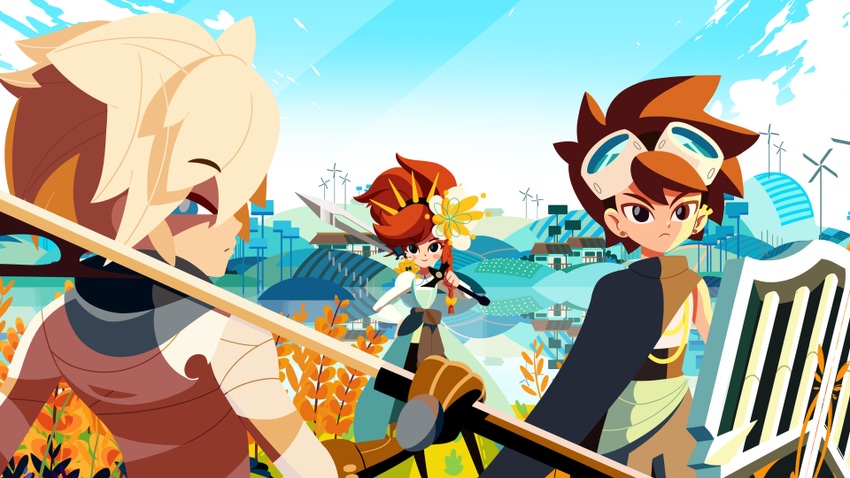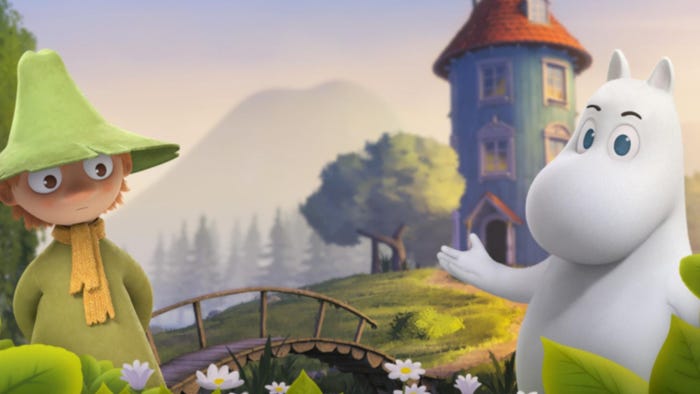"What we wanted to do is take those very normal, day-to-day elements that we have here in Colombia and turn them into these magical versions of themselves."

Cris Tales, the latest from Colombian developers Syck and Dreams Uncorporated, is a love letter to the developers’ home country and the games they grew up adoring. The stylish turn-based RPG draws heavy inspiration from Japanese video game classics such as Chrono Trigger and the Final Fantasy series, and is also a landmark in the developers’ trajectory in the games industry.
The game is set in the fictional Crystallis Kingdom — a fantasy land with vistas heavily inspired by structures and landscapes from Colombia — and hands players control over protagonist Crisbell. The young orphan with a peppy personality and a big heart is chosen by a higher power to save the realm from impending doom, but in order to do so, she discovers time manipulation powers to aid her in her journey.
While the plot relies on elements very familiar to players acquainted with Japanese-style RPGs, Cris Tales doesn't shy away from paying homage to its influences while also injecting new life into the genre. The game catches the eye with its hand-drawn aesthetic, engaging turn-based combat that incorporates time warping, and charming characters, all elements that were emphasized when the concept for the game was being developed.
In a recent interview with Game Developer, Carlos Rocha Silva, CEO of the Bucaramanga, Colombia-based studio, said the team of just under 30 developers and artists took inspiration for the game’s characteristic mechanic of an on-screen triangle dividing the screen between the past, present and future timelines from the Nintendo DS. Nintendo’s portable system is commonly known for having two screens and being the first gaming device that allowed for tactile input.
“I love the idea of the dual screen on the original Nintendo DS,” Rocha Silva said. “That was absolutely revolutionary. It was chameleon-like, having to split your visibility to look at the two screens.”
Rocha Silva’s interest in a multi-screen gameplay experience only grew after he watched a demo for a virtual reality game that offered similar screen splitting feature during IndieCade, an international independent game festival in Los Angeles.
“I mixed [those two ideas] and I thought: ‘okay, so what if you could see the past, the present and the future at the same time on the same screen?’”
Other core elements, such as the art style and gameplay came along as the team continued to draw from their inspirations.
“(Our art director) came up with the idea of a little Disney princess from Colombia,” Rocha Silva said of Crisbell, who often displays all the bravery and heroics seen from the leading character of an animated Disney film.
When it comes to gameplay, Cris Tales wears its influences on its sleeve. Inspiration for combat and exploration blossomed from the developers’ love for traditional Japanese RPGs from the 1990s. Rocha Silva cited Final Fantasy VI, Chrono Trigger, and Super Mario RPG as the leading role models for Cris Tales.

Beyond other video games, Rocha Silva also mentioned other cultural and artistic media from Japan as having far-reaching sway in how Cris Tales came about.
“I think I have been more influenced as a game creator and as a gamer from Japan than I have been by the West,” he said. “I am heavily influenced by anime and manga. I wouldn't even dare to say that anime or manga are bigger (in Colombia) than they are in the U.S.”
To paint a picture, Rocha Silva said, the anime Saint Seya, known to people in Latin America as Caballeros del Zodiaco is exponentially more popular in Colombia than it is in the States.
“I liken (Saint Seiya) as being as strong in Colombia as Dragon Ball is everywhere else. In some cases, even bigger,” he said.
In a sense, Cris Tales is meant to evoke that feeling of being young and getting lost in a vast world that begs to be explored, the Colombian game maker said..
“Something that I am very glad that we accomplished is that, as a game director, it's very difficult to actually attach feelings and sentiment to a game,” Rocha Silva said. “ So I am very happy that a lot of the reviews highlighted that Cris Tales makes them feel like they are 10 years old again, playing a game they adore.”
As for its legacy as a cultural artifact that represents Colombia, Rocha Silva said the team was highly aware of the aspects of Colombian culture they wanted to highlight, as well as the negative global media portrayals they wanted to avoid.
An example of this is the studio’s vision of “endemic fantasy,” a take on Colombia’s rich tradition of magical realism in literature. Nobel Prize laureate and author Gabriel Garcia Marquez, a native of Colombia, is perhaps the biggest proponent of this genre of fiction in which a perspective of the modern world is explained in fine, realistic detail, while also adding elements of magic and fantasy.
“What we wanted to do is take those very normal, day-to-day elements that we have here in Colombia and turn them into these magical versions of themselves,” Rocha Silva said, alluding to an example of one of Cris Tales’ main characters Matias, who is a talking frog that aids Crisbell in her adventure. “For instance Matias is actually based on the golden poison frog from Colombia.”

Artistically, the game also takes from Colombia’s most impressive architecture. For instance, Rocha Silva noted the first cathedral in the game, where Crisbell discovers her time altering powers, is actually based on the Las Lajas Shrine, a gothic sanctuary located in the southwestern Colombian state of Nariño.
“We definitely have very strange places during Colombia,” he said, referencing another hub world players can visit in game such as the salt mines modeled after Colombia’s Salt Cathedral of Zipaquirá.
Other cities in the game, like St. Clarity, are also modeled after coastal destinations in Colombia’s eastern seaboard.
The game also illustrates harsh realities seen in Colombia.
“There are floods in the game and that actually happens in some cities in Colombia when the rainfall is out of control,” Rocha Silva said. “The game also deals with the heavily pronounced social injustice and social inequality. We have a lot of wealthy people here and we have way too many poor people in Columbia and we really want to highlight those aspects of our culture, cities and lives.”
Some game characters, the game maker said, are stand-ins for working class Colombians.
“You will see a woman that is selling street food and street food here in Columbia is truly how you earn your living,” he said. “Half of our country has informal jobs. So we really wanted to highlight that part of life here.”
The creators wanted to stray from the negative portrayals exported by movie and television studios in the global north, painting Colombia as a war-torn country at odds with itself since the rise of the illegal drug trade in the 1970s.
Rocha Silva, who has been a regular at worldwide gaming events like the Game Developers Conference in San Francisco since 2012, often hears about these stereotypes from friends in the industry.
“My friends from overseas all ask me ‘is Colombia still the way they show it in (the Netflix show) Narcos,’” he said. “Colombia is a different country and we wanted to show all of that. We definitely did not want to see any of those conversations surrounding our game.”
In many ways, Rocha Silva said, the studio is also applying Cris Tales’ philosophy of understanding the past in order to act in the present and change the future.
Although the veteran developer has been in the industry for a decade-plus, previous efforts to break through commercially have taught Rocha Silva valuable lessons. Among them, focusing on the core game mechanic, in Cris Tales’ case the time manipulation aspect, and building a strong core gameplay that players will understand and be receptive to.
“Actually making an RPG, even though it was challenging, it was easier for us because we had a base to start with,” he said. “We had a pillar of genre elements that we could look to for reference in other games, researching what they did right and where they went wrong.”
In the present, Rocha Silva said, the game’s reception is positive and rewarding.
“I am very happy because the game has been very well received,” he said. “There are of course a few things to iron out here and there, but mostly, in general, we are extremely happy.”
He says the team aspires to make bigger games in the future, and grow from the lessons learned during the development of Cris Tales. One such improvement the team will benefit from going forward is having a more experienced workforce.
“Most of the people that we hire didn't make video games before aside from very small prototypes,” Rocha Silva said. “So we had to teach ourselves how to make games. Now that we feel that we've grown so much, I think that we are in a position to actually plan out things in bigger and better ways.”
Read more about:
FeaturesAbout the Author(s)
You May Also Like








